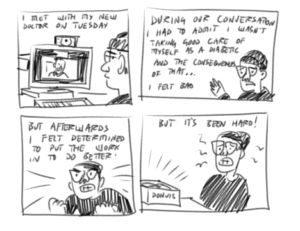creative rituals
Art and wellness projects for inspiring healthy habits
Intentional Re-Entry with multi-disciplinary artist Mia O’Connor Smith
Approximate time for re-entry: 5 minutes
Approximate time for portal creation: it depends on your idea, but plan on 30 min. to 1 hour
In facilitating her OK YOU workshops, Mia always began by having her group leave the room and enter again. She called this “intentional re-entry.” Mia:
I started dancing when I was three. The stage and studio were places that, as soon as I walked through the doors felt a change. I think it was the sacredness of those spaces. I see that similarly in the classroom. Each time you walk through a door, things are different on the other side. The people are different, the energy is different, because of what we all carry inside us.
Kids understand better when you make things physical and so if you’re explaining the practice as they’re moving their bodies, it becomes a part of their routine and they know what to expect when they’re coming into your space.
That’s why, in my groups, we would step out of the room and come back in, to acknowledge the energetic difference and acknowledge what we’re all bringing into the room. Encouraging young people to be more aware of their bodies in a space has turned out to be a really powerful tool in our workshops.
The beauty of this practice is that it slows down the transition from whatever kids are dealing with at home or in the halls to the present moment, giving students the opportunity to reset and decide how they want to show up, which can have a powerful effect on their self-confidence, self-image, and emotional wellbeing.
To practice intentional re-entry with your students:
Have everyone gather or line up outside in the hall. Ask your students to think about what they’re currently feeling and what they would like to feel when they walk back inside. Then, before re-entering the classroom, have everyone take a deep breath and embody this new feeling by…
…shaking out their bodies and striking a new pose that reflects what they want to feel (the “act as if” principle).
…turning their desired feeling into an affirmation. For example: I am happy, I am strong, I am loved. As they take a deep breath, have them say this affirmation either to themselves or aloud.
….introducing EFT tapping, either on its own or along with affirmations. If you aren’t familiar with this practice, you can read more about its use in releasing anxiety, stress and trauma here.
You can also try:
…turning your classroom door into a portal by decorating it, either on your own or with your students’ ideas and involvement.
…having students design their own portals and post their drawings around the outside of your door.
…assigning a door greeter to remind students to slow down and take a deep breath before passing through the portal.
Whatever your approach, it’s all about giving students that moment to stop and consider the space they are about to enter, what they are carrying with them, and how they want to show up. That’s a practice that will serve them well into their futures.
Give worry a time out with OK You’s kathleen lane
Approximate time: 10 minutes for group reflection and sharing
This grounding and connecting ritual normalizes feelings and gives students—and all of us— practice in naming, separating from and exercising our power of choice in how we want to engage with our emotions.
Over time we also get to see difficult moments and emotions as passing, not a permanent state of being.
Supplies: A stone and paint pen or permanent marker (or paper and pen), and a bag or other container for collecting stones.
Step-by-step project instructions can be found here.
Journal Comics with cartoonist Jonathan Hill
Approximate time: 30+ minutes
This personal reflection & expression ritual is a great one for developing self-awareness and confidence in navigating difficult moments and emotions.
By tracking day-to-day feelings and events, students can look back and see what challenges are no longer present for them, celebrate their courage and resilience, and move forward with greater self-confidence.
Journal Comics also give students a “cool” way of sharing their challenges with each other.
Supplies: Something to write on and something to write with. A journal is ideal but not necessary. Here are our instructions for making an art journal.
Check-in games with actors Carmen Burbridge and Ebony Priddie
Approximate time: 5-10 minutes per exercise
1. Personal check-ins
How are you feeling today? What’s going on inside you that would be helpful for others to know? In this short video, Carmen and Ebony model the simple but oh-so-important grounding ritual of checking in with ourselves and others.
2. The Gibberish Game
It’s not always easy to find the words to express how we feel. That’s where the gibberish game comes in. Instead of words, one person expresses their feelings in made-up words and sounds, and their partner attempts to translate what it is they’re saying. slijjy rottumata vroo!
3. One-word stories
There’s no telling where a one-word story will go, which is why they are so very fun. All you need to get started is a partner (or group) and a word. One-word stories are a great way to explore complex feelings and ideas, as Carmen and Ebony demonstrate in this short video.







 Play video!
Play video!


 Play video
Play video Play video
Play video